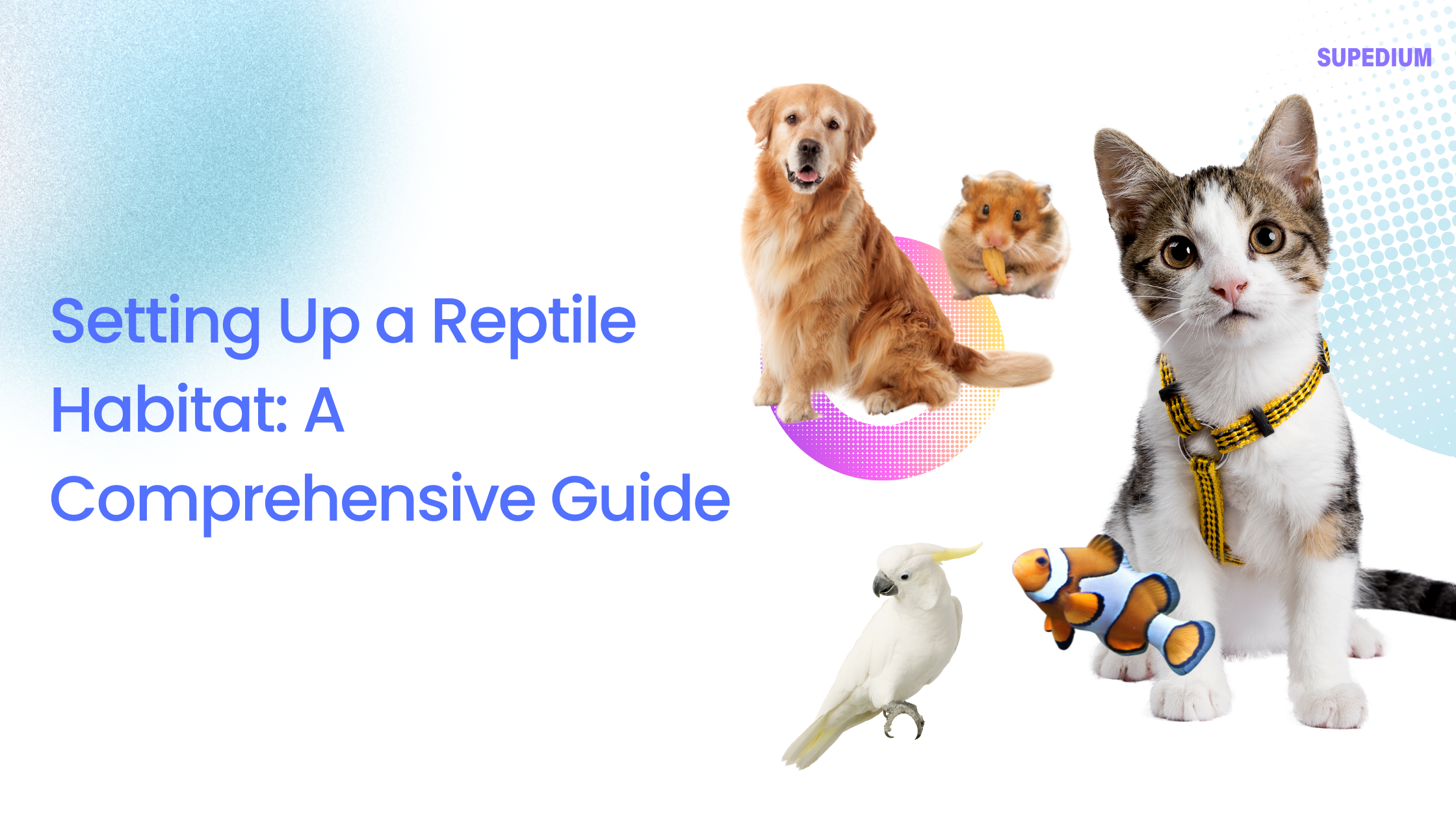Table of Contents
![]()
Creating an optimal habitat for a reptile is essential for its health, comfort, and overall well-being. Unlike mammals, reptiles have unique needs and environmental requirements that must be meticulously addressed. This guide provides a detailed overview of how to set up a reptile habitat, covering everything from choosing the right enclosure to maintaining proper humidity and providing enrichment.
Choosing the Right Enclosure
Size and Type
The first step in setting up a reptile habitat is selecting an appropriate enclosure. The size and type of the enclosure depend on the species of reptile you are keeping. Smaller reptiles like geckos might do well in a 20-gallon tank, while larger species like boa constrictors require larger, custom-built enclosures. Options include glass terrariums, plastic tubs, and custom-built setups. Glass terrariums are popular for their visibility and ease of access, but they require proper ventilation to prevent humidity build-up.
Ventilation
Proper ventilation is crucial for maintaining a healthy environment. Insufficient airflow can lead to problems like mold growth and respiratory issues in reptiles. Ensure that your enclosure has adequate ventilation, which can be achieved through screen tops or ventilation holes. This will help in maintaining air circulation and preventing stale air from accumulating.
Accessibility
The enclosure should be easy to access for feeding and cleaning. Features such as sliding glass panels or removable tops can make it easier to interact with your reptile and maintain the habitat. Additionally, ensure that the enclosure has secure closures to prevent escapes.
Heating and Temperature Control
Temperature Requirements
Reptiles are ectothermic, meaning they rely on external heat sources to regulate their body temperature. Different species have specific temperature needs, which often include a temperature gradient within the habitat. For example, a basking spot might need to be between 85-90°F, while the cooler side of the enclosure should be around 75°F. It’s important to replicate these conditions to keep your reptile comfortable and healthy.
Heating Equipment
Several heating options are available, including heat lamps, under-tank heaters, and ceramic heaters. Heat lamps are useful for providing basking spots and can be adjusted for the required temperature. Under-tank heaters can create a warm spot on the substrate, while ceramic heaters provide consistent, non-visible heat. Proper placement of these heaters is crucial to ensure even heating and prevent hotspots that could cause burns.
Thermoregulation
To allow your reptile to regulate its temperature effectively, provide a temperature gradient within the enclosure. This means having a warmer area (basking spot) and a cooler area (thermoregulatory zone). Use thermometers or heat mats to monitor and adjust temperatures as needed.
Lighting
Light Requirements
In addition to heating, reptiles often require UVB and UVA light to support their health. UVB light helps in the synthesis of vitamin D3, which is crucial for calcium absorption and preventing metabolic bone disease. UVA light affects their behavior and appetite. Research your specific reptile’s needs to determine the right type and intensity of lighting.
Types of Lighting
UVB bulbs are available in various forms, including fluorescent and compact bulbs. Fluorescent UVB bulbs are effective for providing widespread UVB coverage, while compact UVB bulbs are useful for smaller enclosures. Additionally, heat lamps or daylight bulbs can simulate natural light cycles. Regular replacement of these bulbs is necessary, as their UVB output diminishes over time.
Placement and Maintenance
Position your lighting equipment to cover the entire enclosure effectively. Ensure that the UVB light is placed at the recommended distance from the basking spot, as specified by the manufacturer. Regularly replace bulbs and clean the fixtures to maintain optimal light conditions.
Substrate and Flooring
Types of Substrate
The choice of substrate depends on the species of reptile and its natural habitat. Common substrates include reptile carpet, paper towels, sand, soil, and moss. Reptile carpet and paper towels are easy to clean and suitable for many species, while sand and soil can be more natural but require careful management to avoid ingestion and impaction.
Cleaning and Maintenance
Regular cleaning is essential to prevent the build-up of waste and bacteria. Spot clean daily to remove any waste, and perform a complete substrate change and sanitization periodically. This helps maintain a healthy environment and prevents the spread of disease.
Humidity and Water
Humidity Needs
Humidity is another critical factor in a reptile’s habitat. Different species have varying humidity requirements, from very dry conditions to high moisture levels. Use a hygrometer to monitor humidity levels and adjust as needed. For species requiring higher humidity, you can use misting systems or humidity boxes. Conversely, for species needing drier conditions, ensure adequate ventilation and avoid excessive moisture.
Water Supply
Provide fresh, clean water at all times. Water bowls should be large enough for the reptile to drink and, if needed, soak. For species that drink infrequently, a drip system might be necessary. Regularly clean and refill water dishes to prevent the growth of harmful bacteria.
Enrichment and Habitat Accessories
Hiding Spots and Shelters
Hiding spots are vital for reducing stress in reptiles. They provide a sense of security and allow reptiles to retreat when feeling threatened. Include various types of hides, such as caves, logs, or commercially available reptile hides, to offer a variety of shelter options.
Climbing Structures and Décor
Many reptiles enjoy climbing and exploring their environment. Provide climbing structures such as branches, vines, and ledges made from safe, non-toxic materials. Ensure that these structures are securely placed to prevent accidents.
Additional Features
Enhance the enclosure with additional features that mimic the natural habitat. Use substrate additions like rocks, plants, and moss to create a more realistic and engaging environment. Ensure that all materials used are safe for your reptile and do not pose a choking hazard or cause injuries.
Feeding and Diet
Species-Specific Diet
Understanding the dietary needs of your reptile is crucial for its health. Reptiles have varied diets, including insects, plants, or rodents. Research the specific dietary requirements of your species and provide a balanced diet. Supplements such as calcium and vitamins may also be necessary to ensure proper nutrition.
Feeding Setup
Implement an effective feeding setup to avoid contamination of the habitat. Use feeding dishes or tongs to offer food, and monitor feeding behavior to ensure your reptile is eating appropriately. Avoid overfeeding and provide appropriate portion sizes based on the species’ dietary needs.
Health and Monitoring
Regular Health Checks
Regular health checks are essential for detecting any issues early. Monitor your reptile for signs of illness, such as changes in behavior, appetite, or physical appearance. Establish a relationship with a veterinarian experienced in reptile care for routine check-ups and any health concerns.
Environmental Monitoring
Consistently monitor environmental conditions using thermometers, hygrometers, and other tools to ensure the habitat remains within the required parameters. Regularly check and adjust heating, lighting, and humidity as needed.
Troubleshooting Common Issues
Temperature Fluctuations
Temperature fluctuations can disrupt your reptile’s well-being. Address any issues with heating equipment promptly and ensure the temperature gradient is properly maintained. Use reliable equipment to minimize fluctuations.
Humidity Problems
If you encounter issues with humidity, adjust your misting schedule or ventilation to stabilize levels. Regularly check the hygrometer and make necessary adjustments to maintain the ideal humidity for your reptile.
Behavioral Issues
Stress or aggression in reptiles can often be attributed to environmental factors. Assess the habitat for potential stressors, such as inadequate hiding spots or improper temperature gradients. Make necessary adjustments to improve the overall environment.
Conclusion
Setting up a reptile habitat requires careful consideration of various factors to ensure the health and well-being of your pet. By addressing the needs for enclosure size, heating, lighting, substrate, humidity, and enrichment, you can create a thriving environment for your reptile. Continuous learning and monitoring are essential for maintaining optimal conditions and ensuring a happy, healthy reptile.
Share This





Be the first to comment